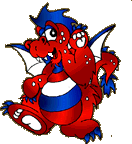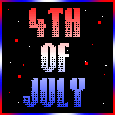"Proclaim liberty throughout all the land unto all the inhabitants thereof." — from the Liberty Bell

 This important holiday recalls the signing of the Declaration of Independence on July 4, 1776 and is regarded as the birthday of the United States as a free and independent nation, though most Americans simply call it the Fourth of July for the date upon which it always falls. A day of picnics and patriotic parades, followed by a night of fireworks, the flying of the American flag is widespread.
This important holiday recalls the signing of the Declaration of Independence on July 4, 1776 and is regarded as the birthday of the United States as a free and independent nation, though most Americans simply call it the Fourth of July for the date upon which it always falls. A day of picnics and patriotic parades, followed by a night of fireworks, the flying of the American flag is widespread.
By the middle of the 1700s, the thirteen (13) colonies that made up part of England's empire in the New World were finding it difficult to be ruled by an unjust king over 3,000 miles across the Atlantic Ocean. They were tired of the taxes imposed upon them. But independence was a gradual and painful process. The colonists could not forget that they were British citizens and that they owed allegiance to King George III.
A tea party and a Massacre were the two main events which sped up destiny, along with general unrest, united the colonists. In 1767, a tea company in India owned by England, was losing money. In an effort to save the company, England levied a tax on tea sold in the colonies in 1773. Partly as a joke, Samuel Adams and other Bostonians dressed up as Indians and dumped a cargo of the India Company Tea into the Massachusetts Bay. King George III was neither amused, nor did he lift the tax on tea. In the Boston harbor, British soldiers were jeered and stoned by colonists who thought the soldiers had been sent to watch them. The soldiers fired into the crowd and killed a few citizens. The colonists, however, exaggerated the number killed and called it a massacre.
Virginia took the first step toward independence by voting to set up a committee to represent the colonies. This First Continental Congress met in September of 1774. They drew up a list of grievances against the crown which became the first draft of a document that would formally separate the colonies from England. George Washington took command of the Continental Army and began fighting the British in Massachusetts. For the next eight years, colonists fought fervently in the Revolutionary War.
 In the meantime, a war of words was being waged in Philadelphia, Pennsylvania. On July 2, 1776, the Second Continental Congress presented and debated a second draft of the list of grievances, and John Hancock, the president of the Second Continental Congress, was the first to sign. The document, called the Declaration of Independence, was treasonous against the crown and the fifty-six (56) men who signed it were in danger of being executed.
In the meantime, a war of words was being waged in Philadelphia, Pennsylvania. On July 2, 1776, the Second Continental Congress presented and debated a second draft of the list of grievances, and John Hancock, the president of the Second Continental Congress, was the first to sign. The document, called the Declaration of Independence, was treasonous against the crown and the fifty-six (56) men who signed it were in danger of being executed.
Attorney John Adams, the first Vice President and the Second President of the United States, was one of the members of the Second Continental Congress who signed the Declaration of Independence. He wrote to his wife, "I believe that it will be celebrated by succeeding generations as the great anniversary festival … it ought to be celebrated by pomp and parade, with shows, games, sports, guns, bells, bonfires and illuminations from one end of this continent to the other …"
The Continental Congress adopted the final draft of the Declaration of Independence on July 4, 1776. From July 8, 1776, until the next month, the document was read publicly and people celebrated whenever they heard it. The next year, in Philadelphia, bells rang and ships fired guns, candles and firecrackers were lighted. But the War of Independence dragged on until 1783, and in that year, Independence Day was made an official holiday. 1941 Congress declared 4th of July a federal holiday.


Celebrations Today
John Adams may have predicted the later Independence Day celebrations or perhaps he started traditions with his words. Every July 4th (except for the U.S. Virgin Islands, where celebrations are held a week prior to the climax on 4th of July), Americans have a holiday from work. Communities have day-long picnics with favorite foods like hot dogs, hamburgers, potato salad, baked beans and all the fixings. The afternoon activities would not be complete without lively music, a friendly baseball game, three-legged races and a pie-eating or watermelon-eating contests. Some cities have parades with people dressed as the original founding fathers who march in parades to the music of high school bands. At dusk, people in towns and cities gather to watch the fireworks display. Wherever Americans are around the globe, they will get together for a traditional 4th of July celebration!
The Declaration of Independence was first read in Philadelphia, Pennsylvania. Today, at the Freedom Festival at Independence Hall, costumed Americans re-enact historical scenes and read the Declaration of Independence for the crowd. In Flagstaff, Arizona, Native Americans hold a three-day pow-wow around the Fourth of July, with a rodeo and dancing. In Lititz, Pennsylvania, hundreds of candles that were made during the year are lighted in the park at night and floated in the water while a "Queen of Candles" is chosen. The ship U.S.S. John F. Kennedy comes in full sail to Boston Harbor in Massachusetts on the Fourth of July, and the Boston Pops Orchestra plays a musical concert of patriotic songs as more than 150,000 people watch fireworks burst over the water.


Celebratory Icons
The Fireworks Family
New Castle, Pennsylvania, is home to the Vitale Fireworks Display Company, responsible for more than one thousand fireworks shows every year. In 1922 Constantino Vitale brought his expertise at making fireworks from Italy to the United States. He passed his secrets on to his four sons, and since then the company has been making Americans exclaim the many "ooohhhs" and "aaahhhhs" at the lighted colors in the sky on Independence day, as well as many other occasions. "It's like putting on a ballet show except that the dancers were above, painting the sky," says Vitale's granddaughter. "Seeing that spectacular display in the sky made me really love the country."
The Liberty Bell
The sight and sound of a ringing bell represents freedom to most Americans because of the Liberty Bell that rang in Philadelphia when the new country was born.
In 1752 the new bell arrived safely from England, but at the first blow from a hammer to test it, it cracked. Not wanting to delay by returning the bell to England, the officials ordered bell founders in Philadelphia to remedy the fault. Two times it was recast before it was finally ready. On July 8, 1776, the bell rang to mark the occasion of the adoption of the Declaration of Independence. On April 16, 1783 it proudly announced the proclamation of peace and the newly won independence of the United States of America.
At every event of national importance, the Liberty Bell joined its harmonious tones to the general acclaim: in 1789, the election of George Washington; in 1797, the election of John Adams; in 1799, the death of Washington; and in 1801, the election of Thomas Jefferson. On July 4, 1826, the bell was nearly three quarters of a century old, and the nation whose birth it had helped to announce was now a lusty youngster of 50. Joyous indeed was the bell's sound on that occasion. Then, on July 8, 1835, while tolling for the funeral procession of John Marshall, Chief Justice of the Supreme Court and one of the signers of the Declaration of Independence, the great bell cracked.
Fearing that the crack would eventually destroy the historic bell, officials ordered it taken down from the tower. It was after this that the Liberty Bell received its name. Since then, the bell has been on display but has never rung. In fact, no one living knows the voice of the Liberty Bell, for it has never spoken since 1835. The crack which appeared on that occasion is prevented from widening by a mechanical device, called a spider, installed inside the bell.
A few years ago the bell foundry in London that originally cast the great bell made a friendly proposal - to ship the bell back to England, melt it, and recast it at no cost to the United States. The keepers of the bell considered the offer very seriously before giving an answer. Then they decided that the cracked liberty bell is a cherished symbol of America's struggle for freedom. Just as a man's facial lines and creases are a visible sign of the stress and strain he has survived, so the crack in the Liberty Bell serves to remind Americans that their forefathers did not win liberty for their country and its people without strain and stress - and even extensive fractures. Therefore, on behalf of the American people, the officials thanked the London foundry for its generous offer, but refused, adding: "We like the bell as it is, crack and all. It is an important part of our heritage."


Celebratory Music
Yankee Doodle
This patriotic song has derogatory origins. The music and words go back to 15th century Holland, as a harvesting song that began, "Yanker dudel doodle down." In England, the tune was used for a nursery rhyme, and later a song making fun of Puritan church leader Oliver Cromwell, because "Yankee" might be a mispronunciation of the word "English," and "doodle" refers to a dumb person. However, in truth, it was British surgeon Richard Schuckburgh, who wrote the words which ridiculed the ragtag colonists fighting in the French and Indian War. Soon after, the British troops used the song to make fun of the colonists in the Revolutionary War. But despite all of this, it became the colonists' rallying anthem for the Revolutionary War.
America, the Beautiful
Katherine Lee Bates, an English professor at Wellesley College, rode in a horse-drawn wagon up Pike's Peak, a mountaintop-in Colorado in 1893. She saw a view of the mountains that few people saw in those days and was inspired by her glimpse the "spacious skies" and "purple mountains" to write a poem, which became the first verse of the song. The public loved the poem, and Miss Bates was encouraged to set it to music She chose the music of a hymn by Samuel Ward. The words and music travelled around the world, and today Mexico, Canada and Australia sing it with their own countries' names instead of "America."
Every so often, a movement is started to make "America the Beautiful" the national anthem instead of "The Star-Spangled Banner," largely because it was not written as a result of a war. The tune is easier to sing and the whole country is praised, not only the flag.

The HTML, FLASH, JAVA, graphics and original descriptions contained on these pages are not public domain and are not available for download or use. Unless otherwise specified these are all the exclusive property of Copyright ©1994-2016 MOON Productions® The Rattt Trap, Cybele Designs and Designs by Char are owned by MOON Productions. All rights reserved. Best viewed at 1024 x 768 with IE 5.5 or higher.